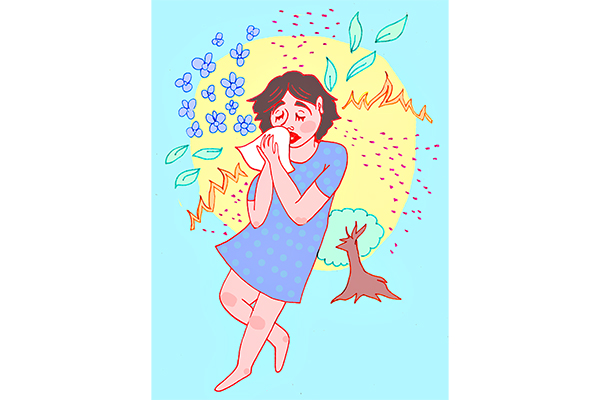Runny nose, watery eyes, sneezing, headache and fatigue. For students experiencing Austin’s allergies, they know how these symptoms can impact their day-to-day lives.
Seasonal allergies affect more than 20% of people, but Austinites are more likely to suffer the consequences. Austin is one of several cities with a year-round allergy season. Fluctuating during certain parts of the year, allergens such as pollen and ragweed can impact aspects of students’ college experience including walking between classes, maintaining focus or even studying.
Dr. Gary Albertson is an allergist at Victory Medical Center in Austin. He said a person’s likelihood for allergies depends on their geographic location, its climate and rainfall.
“Because of the rain we get and all the trees and grasses, (Austin has) a big share of the allergy problems in Texas,” Albertson said.
Austin is ranked one of the 50 worst cities for Spring allergies, according to a 2018 study by the Asthma and Allergy Foundation of America. One of the worst times for allergies is during mountain cedar season, which usually runs from December to February. According to the Texan Allergy & Sinus Center, mountain cedar is one of the most potent allergens in Texas.
Biology sophomore Jaslyn Huang said her allergies have been especially bad this season. In addition to constantly having to blow her nose and deal with a sore throat and cough, Huang said she also has asthma, which causes wheezing while walking between classes.
“My eyes are always itchy and that’s kind of been today and yesterday,” Huang said. “It’s just really uncomfortable and hard to focus in class.”
Although Huang said her hometown of Kerrville can also be bad for allergies, Austin’s allergies are different because of their unpredictability.
“Last year I didn’t really have a problem with them, but this year it’s been a lot worse,” Huang said.
Economics junior Grant Rexrode said he was tested for allergies last summer and was allergic to 33 of the 38 allergens he was tested for but has been unable to use his allergy drops because of a negative reaction he had to them.
“I wake up in the morning and I cannot breathe out of one of my nostrils usually,” Rexrode said. “I’ll sneeze and it takes an hour for all my congestion to get out.”
Albertson said it takes a couple of years for people to develop allergies to the area they live in. He said if students experience a runny nose and sore throat during their first year in Texas, it is most likely not allergies.
“(Students) have to be exposed to (allergens) for a while to become allergic,” Albertson said.
Huang said her allergies hinder her ability to do her best work in classes. When her allergies act up, coupled with asthma symptoms, she has to work harder to pay attention in her classes.
“Just walking across campus or walking a short distance, I would need my inhaler and I would be wheezing a lot,” Juang said. “That was really annoying because I felt like I couldn’t breathe and it was a struggle just to walk from class to class.”
Rexrode said the worst of his allergies are in the morning, but they continue throughout the day. He said allergies primarily affect his sleep and have worsened since moving to Austin.
“I wake up every day and it’s just the first thing,” Rexrode said. “I can’t sleep because I can’t breathe.”















